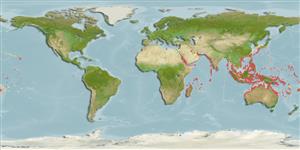Bivalvia |
Arcida |
Arcidae
Environment: milieu / climate zone / depth range / distribution range
Ecology
Benthic; depth range 0 - 46 m (Ref. 75840). Tropical
Indo-Pacific: from East and South Africa, including Madagascar, the Red Sea and the Persian Gulf, to eastern Polynesia; north to Japan and Hawaii, and south to Queensland.
Length at first maturity / Size / Weight / Age
Maturity: Lm ? range ? - ? cm Max length : 7.5 cm SHL male/unsexed; (Ref. 348); common length : 5.0 cm SHL male/unsexed; (Ref. 348)
This is the most common Barbatia species of the Indo-Pacific (Ref. 2922). Attached by byssus among rocks, underside of coral slabs, or nestling in crevices. Littoral and sublittoral (Ref. 348). Also occurs in shallow areas of lagoons where it is attached to dead corals (Ref. 65033). Dead shells found on the beaches (Ref. 88739).
Life cycle and mating behavior
Maturity | Reproduction | Spawning | Eggs | Fecundity | Larvae
Members of the class Bivalvia are mostly gonochoric, some are protandric hermaphrodites. Life cycle: Embryos develop into free-swimming trocophore larvae, succeeded by the bivalve veliger, resembling a miniature clam.
Poutiers, J.M. 1998 Bivalves. Acephala, Lamellibranchia, Pelecypoda. p. 123-362. In Carpenter, K. E. and V. H. Niem. 1998. FAO species identification guide for fishery purposes. The living marine resources of the Western Central Pacific. Volume 1. Seaweeds, corals, bivalves, and gastropods. Rome, FAO. (Ref. 348)
IUCN Red List Status
(Ref. 130435: Version 2025-1)
CITES status (Ref. 108899)
Not Evaluated
Not Evaluated
Threat to humans
Harmless
Human uses
Fisheries: commercial
| FishSource |
Tools
More information
Trophic EcologyFood items (preys)Diet compositionFood consumptionPredators Population dynamicsGrowthMax. ages / sizesLength-weight rel.Length-length rel.Length-frequenciesMass conversionAbundance Life cycleReproductionMaturityFecunditySpawningEggsEgg developmentLarvae PhysiologyOxygen consumption
Human RelatedStamps, coins, misc.
Internet sources
Estimates based on models
Preferred temperature
(Ref.
115969): 24.7 - 29.3, mean 28.5 (based on 3234 cells).
Fishing Vulnerability
Low vulnerability (10 of 100).
Price category
Unknown.
